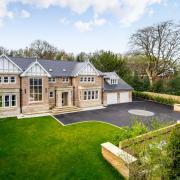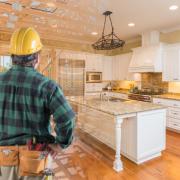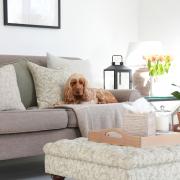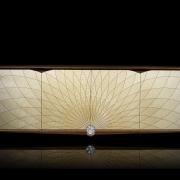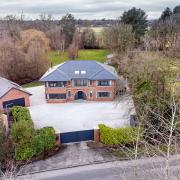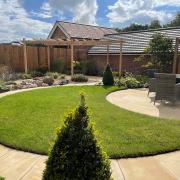Estelle Bilson, of BBC One’s The Bidding Room, designer and owner of famed 70s House Manchester, has now released the definitive guide to the most daring decade in design
Filming for the fourth series of BBC One’s The Bidding Room has only recently completed, and series five is starting any day now, meaning a busy schedule for Manchester’s Estelle Bilson, yet she has still managed to craft an entire book celebrating the 70s, the era once described by The Face (and quite unfairly in Estelle’s view) as the ‘decade that taste forgot’.

“I’d say that right now the 70s is one of the most referenced design decades, stylistically. The younger generations coming through, the Millennials and Gen Z, have never experienced the backlash against 70s design that took place in the 1980s,’ Estelle says, ‘and there’s a whole lot of love for it, there’s definitely a ‘coolness’ about it, again.”
The 80s mockery of 70s design is simply, Estelle believes, a sign of the cyclical nature of style.
“The 1980s saw a new generation, with new attitudes and access to new materials coming through, and of course they pushed back at what they saw as their parents’ design style. If you look ten years back, it’s really bad taste, go back 10-15 years and it becomes niche, 20, 30, 40 years on it gets cool again, with a much wider audience opening up. Enough time has passed that people remember it with nostalgia, and a new generation has discovered the aesthetic.”
We talk about 70s design of course as if it were just one single style, but in that ten-year period there was an awful lot of change, both socially and in the way we decorated our homes.

“Coming out of the 60s there was a lot of style merges going on – you had people wanting the new ultra-modern , the Space-Age stuff, then there was the push-back with the Good Life aesthetic, where people were talking about self-sufficiency and getting off-grid, and by the end of the decade you had punk and you had Laura Ashley, at the same time. So you had women walking around looking like something out of Kate Greenaway next to Sid Vicious with his safety pins and spitting. In that ten-year period you’ve gone from space age to punk amid a huge melting pot of music and fashion and creativity in a way I don’t think we’ve seen since or will see again. This is why I find it fascinating.”
Estelle’s own house is an homage to the 1970s and is a source of inspiration for her own wallpaper, soft furnishings, kitchenalia and art, which she retails through her website, 70shousemanchester.com. It’s also used for photoshoots and filming on occasion, when art directors are seeking the iconic 70s look.
“My home is a complete fantasy of 70s interior design, taken from magazine articles on how superstars lived, adverts for products where everything was really sexy and gorgeous – it's the not the 70s I kind-of remember, or most who lived through that decade remember, it's not the nicotine-stained Artex and woodchip most recall, it’s very much aspirational style, very idealistic. I think that’s one of the things I really like about the decade – everything was new and exciting and fresh. It was so exuberant and bonkers – a lot of really bonkers furniture.”

Estelle says she had been thinking about writing a book about the design era she loves best for some time, but it was an email from a publisher that really kicked her into action.
“I received an email asking if I’d like to contribute to a book, and I had contributed to other people’s books before and I just turned to my husband and said, ‘I don’t want to contribute to another book; if I’m going to do something, I’m going to write my own book,” and I ranted by about 10 minutes. I replied just asking for more information, and they asked if they could call me – and that’s when they asked if I’d be interested in writing a book myself.”
The initial idea was for me to produce a very small book, a gift book, but Estelle had other ideas.
“I wrote the book pitch, and I had never done one before so had no idea what I was doing, so just wrote a lot of ideas and put some pictures in and listed the topics I’d cover and the chapters I’d do, added some sample text about one of the topics, and sent it in.
“It was the longest two week wait ever, and then they called and said yes, they wanted it, but not as a gift book, but as a coffee table book, which was very flattering. Then they gave me 20 weeks to write the whole book, over 45,000 words, and I had a massive panic attack. I had to drop my child at school, then sit down and really just write. I broke it down by subjects – I started with rugs – and then each day write about a new subject, then at the end of each week read it over and fact check everything. I wanted it to be a real reflection of who I am and really put everything into it.”

Estelle’s starting place for the book was to ask herself – if I was starting from scratch, what would I want to know?
“I mapped out how I would build knowledge of the era and went through what to buy, where to source pieces, how to revive pieces, really just what I have learned over the years so you’re not duped. Really, it’s a handbook of what I wish I had known 30 years ago.”
The foreword for Estelle’s book has been written for her by Biba founder Barbara Hulanicki, the 70s style icon who founded fashion brand Biba, planting it firmly in the centre of 70s design culture not just through her fashion designs, but through the interior design of her Kensington boutiques. For any fan of 70s style, Barbara is quite the icon.
“Barbara has followed me for ages on my 70sHouseManchester account,” Estelle says, “from her personal account, and comments all the time on my posts. I sent her a DM to ask if she’d contribute in any way, and no response was forthcoming, which wasn’t unusual – she's nearly 90 now. I have a very good friend who runs a shop called Biba Boys and he emailed her on my behalf. She emailed me straight back and said she’d love to do it and said ‘Call me on WhatsApp, darling.” I was physically shaking and felt sick all day – she was someone who from the age of 13 I had been in awe of, was the reason I ended up studying fashion, was the reason I was into the aesthetic... When you actually get to speak to you’re hero it’s overwhelming. But she’s exactly how you think she will be, and she’s so generous with her time and her experience. I had so many conversations with her – she's wild, she told me so much I can never repeat!”
70s House, A Bold Homage to the most Daring Decade in Design, is for sale on Amazon and on Estelle’s own website.

















